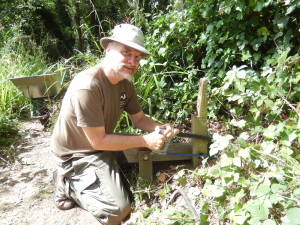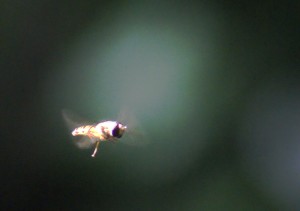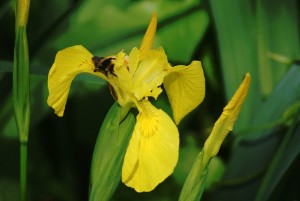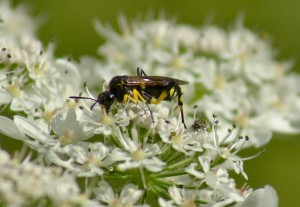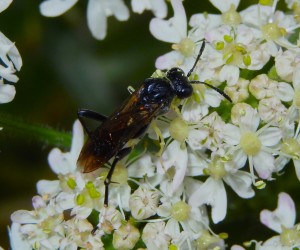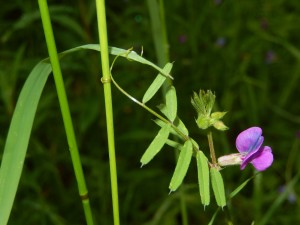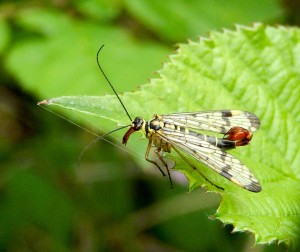
Category Archives: Nature Reserves
Open Day at Gunnersbury Triangle

There was face-painting, and a beekeeper with a demonstration hive and lots of honey, and a brilliant nature walk guided by John Wells, and pond-dipping with damselflies and newts and water scorpions and ramshorn snails and mayfly nymphs, and butterflies all around.

It was seriously sunny and parents pushed pushchairs.
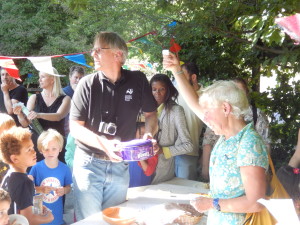
It was hot. There were lots of happy people. We sold masses of cakes, quiches, scones and delicious chocolatey things and tea and coffee and orange squash.
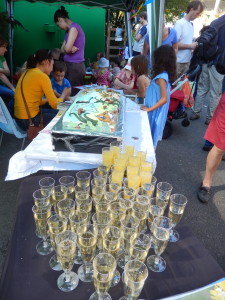
I was too dizzy in the heat and busy with the stall, pond-dipping – and pouring birthday Cava – to take more than a few desultory photos. We had a 30th birthday for the saving of the Triangle from development, two years ago; a party for officials and Trust workers back in May for the day the reserve opened; and now this one for the public. Anyone would think we liked parties or something.
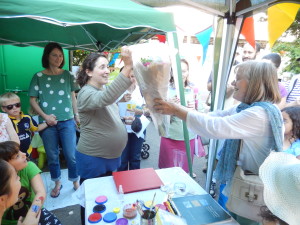
Netty, our Conservation Officer, is now on maternity leave. On behalf of the committee, Jan gave her a card and a big bouquet of flowers.
A Hot Day Down at the Reserve … to Rebuild a Bench
The old bench by the pond had been getting very rotten and rackety, so the back, seat and one of the sides (yeah, 60% of it then) were taken off and the team had the job of putting it all back together using new wood and a bag of coach bolts.
If only things were that simple. Cutting the wood to length wasn’t too complicated. The side stretcher was angled but I managed to measure that with the saw and a pencil and marked holes from the bolts of the surviving stretcher. The bolts were too long, so they had to be cut down with a hacksaw to make it possible to use a socket spanner to tighten them.
Then we marked the position of all five timbers for the back and seat, marked the bolt holes, and drilled them. The two for the back were countersunk for the heads, and fitted to the posts. The bolts were heavier than the old ones, giving us trouble trying to tighten them in the small countersunk space available. I widened the gap with a bit of chiselling and managed to tighten the nuts using a pair of grips. The bolts weren’t long enough for the seat timbers and the thickness of the stringers so we drilled the timbers with starter holes (very narrow) and nailed them down with six-inch nails, a considerable effort. The vibration made the timbers climb up the nail, so when the nail was seemingly fully down, it in fact still had an inch to go and the timber was way adrift of the stringer. We thumped the thing down with a lump hammer and then continued tapping away on the nail with an ordinary hammer. The engineer’s maxim, ‘when all else fails, use b****y great nails’ did come to mind. It was very hot in the sunshine and we gratefully shared a thermos of iced water between us.
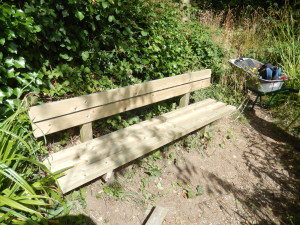
The bench actually looked quite new and professional. Of course if the old posts fall to bits, we’ll have to start over, but it* should last a few more years yet.
* It – the bench – is now officially a “Grandad’s Axe”. You know, grandad’s axe is over 70 years old, and has had seven new shafts and two new heads over the years…
Damsel Ant Mimic Bug Himacerus mirmicoides in Gunnersbury Triangle
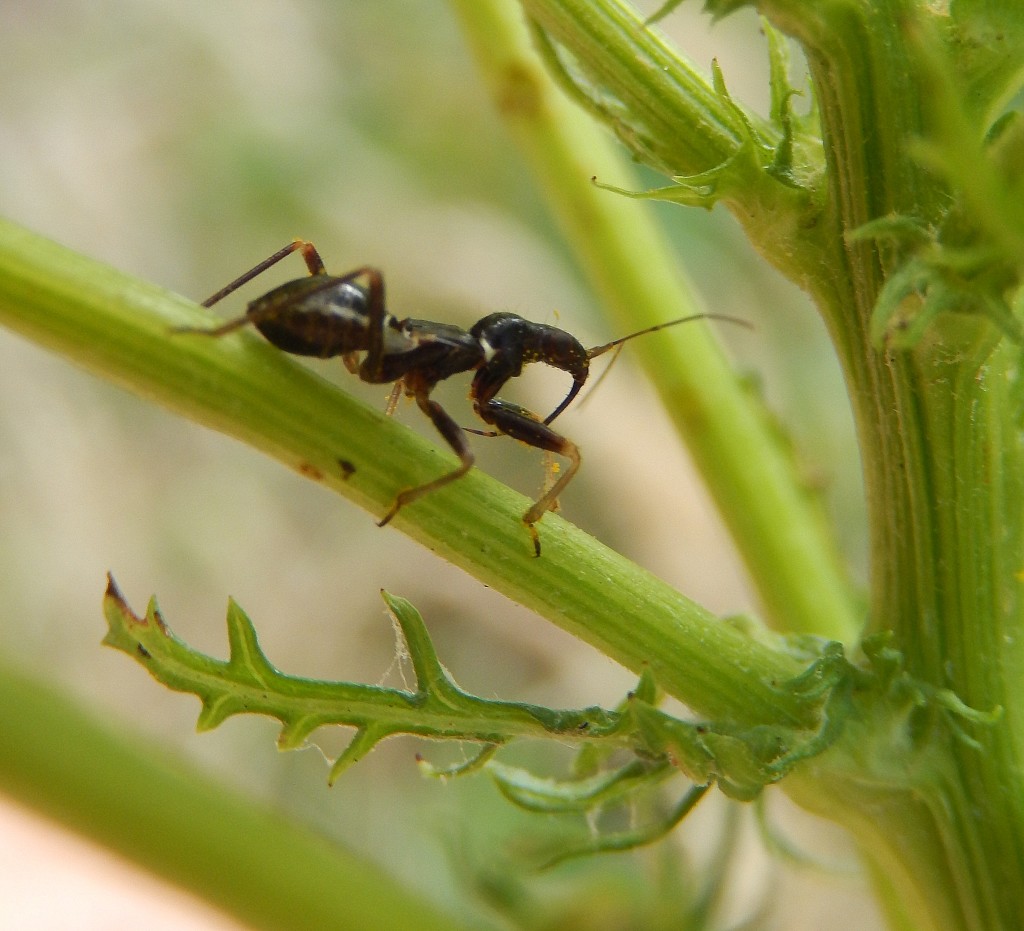
Here’s a bug that avoids being eaten by looking quite enough like an ant to fool a variety of predators. Its name, mirmicoides, means ant-like. Its naturally thick body is made to appear to have a typical ant “waist” with a judicious bit of white camouflage.
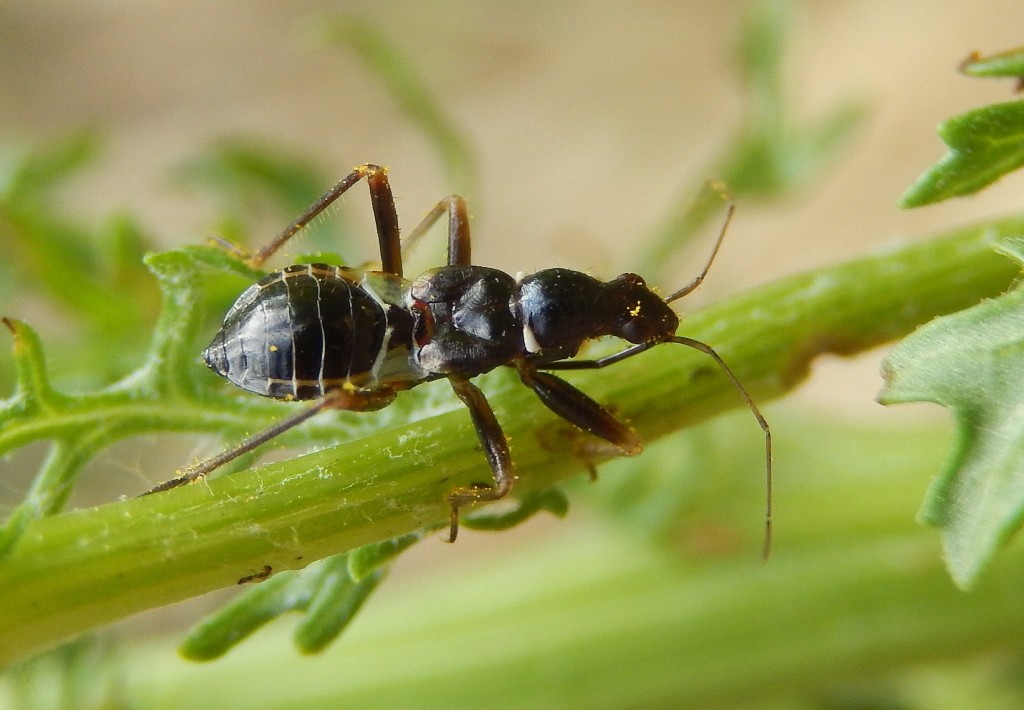
Certainly an interesting “bug” to find. (It’s a true bug, family Nabidae, the damsel bugs, in the Hemiptera.)
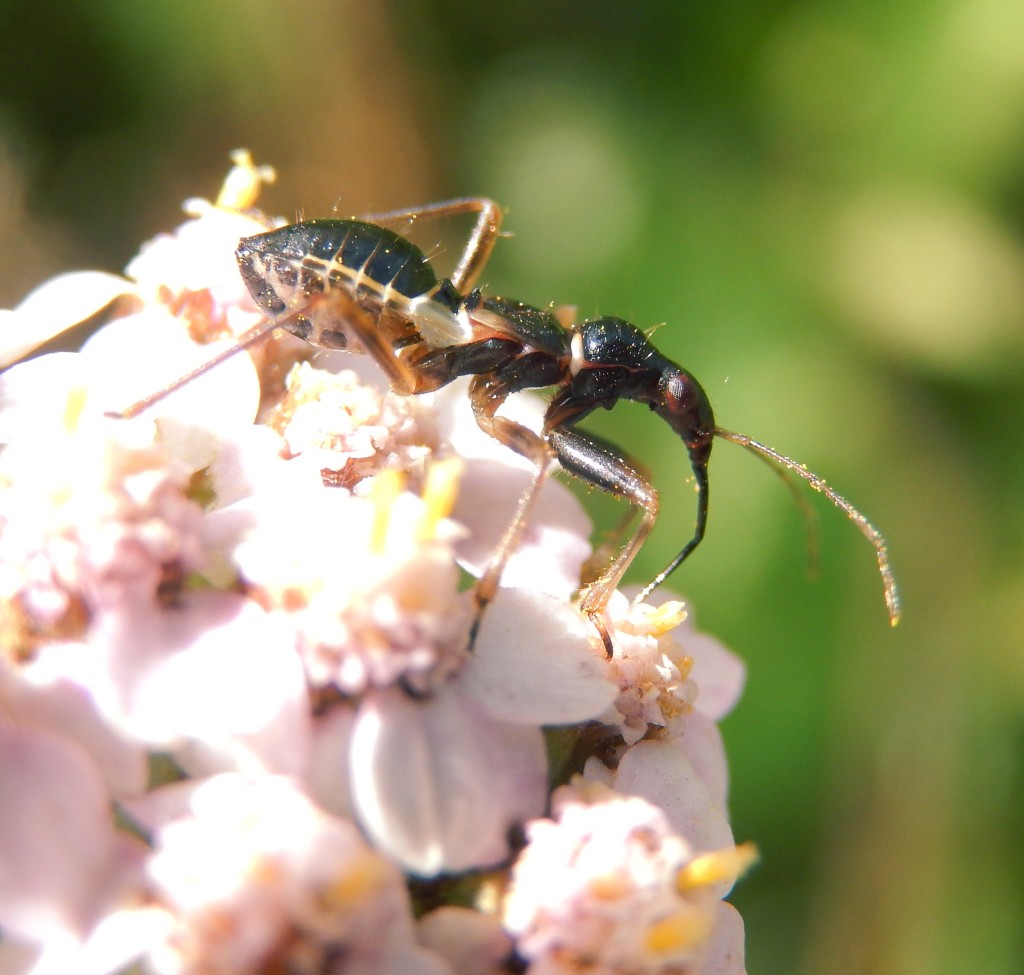
The long and distinctly un-antlike rostrum is held under the head, so predators presumably don’t notice it much. The antennae are similarly much too long to be an ant’s.
Pond-dipping Day, Gunnersbury Triangle
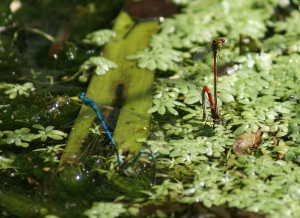
Today I “manned the pond”, resplendent in my The Wildlife Trusts T-shirt complete with badger logo on a black background. I didn’t so much as “stand up for nature” as lie down, hoping that the rather lively toddlers waving pond-nets wouldn’t fall in. Their fortunately very quick mother asked me if any children had in fact fallen into the pond, and I replied truthfully that none had done so, so far. And somehow, they didn’t.
In the warm sunshine, the air above the pond was buzzing with Azure and Large Red Damselflies, some paired up and laying eggs, some males patrolling anxiously, chasing off rivals and presumably hoping for some more females to turn up.
The eager dippers caught lots of Greater Ramshorn Snails, and some smaller ramshorns too. Among the haul were some very small Water Boatmen, midge larvae in reds and yellows, water fleas, a tadpole or two, some mayfly larvae (very zippy) with 7 pairs of gills, and some little damselfly larvae (more placid).
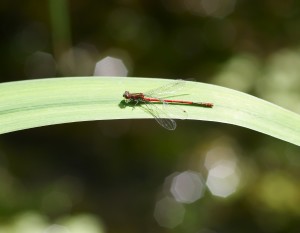
Two Sunday volunteers, relaxed and jolly, joined in the pond-dipping: it turned out that the Conservation Officer was out on a flat roof trying to catch a mallard duck and her six ducklings. Unfortunately the duck escaped while they were trying to scoop up the ducklings, so the rescue was abandoned. If the ducklings can’t be got to a pond soon, they’ll starve as the duck has no other way of feeding them.
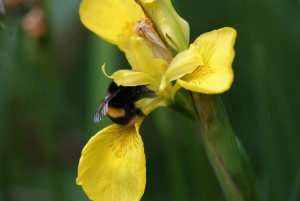
We did carry out another rescue, however: a very large Queen Buff-Tailed Bumblebee was sitting exhausted on the boardwalk. We looked about for flowers, and tried her on a Yellow Iris, with some success; but she soon used up the energy its nectar provided. I suggested some sugar-water. This was fetched, and it seemed to have the right effect, as she perked up considerably.
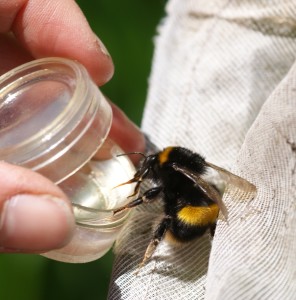
Then, in between telling people about the ridiculously complex fertilisation system in damselflies and dragonflies (indirect fertilisation, sperm storage, yeah) and identifying pond animals, I tried to photograph a mayfly nymph with the absurdly limited depth-of-field of my macro lens. What with the white glare from the pond tray, the sun going into clouds, and toddlers leaning into the light to get a better look, it was somewhat difficult. Here’s what I got.
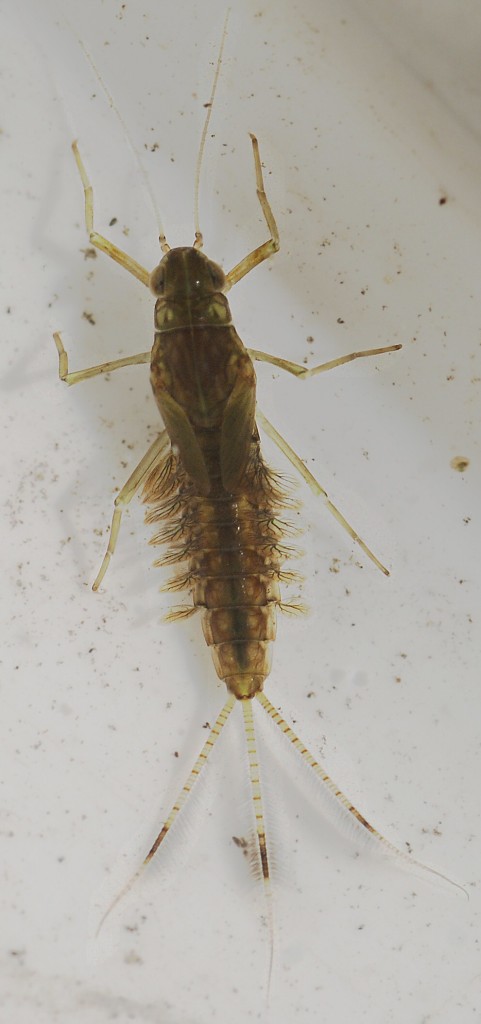
Summer in Gunnersbury Triangle
Suddenly it’s actually hot in the nature reserve.
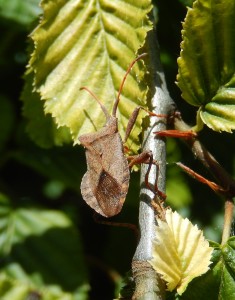
The wildflower meadow in front of the hut shimmered in the sunshine, with bumblebees buzzing around the many Red Campion flowers. A Brimstone visited, for once perching quietly to drink nectar from the flowers. A large brown Shield Bug flew in and clambered up a twig in the hedge. A Red Admiral flew over too. We spent the morning making pegs – like overgrown foot-long sharpened pencils – to fix down the long thin logs we’re using as path edgings. It was pleasant working as a team, with cutting to length and then sharpening with the billhook going on simultaneously.
In the woodland where little shafts of sunlight reached the understory, Speckled Woods danced about or perched.
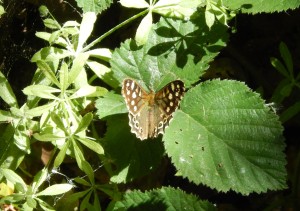
Down at the pond, Azure Blues (the ones with the little drinking-cup mark at the base of their abdomens) darted about, chasing each other off perches and flying in cop with what seemed to be rather few females compared to the number of eager males. A smaller number of Large Red Damselflies similarly chased and mated.

The “Mangrove Swamp” has lost almost all its standing water now: last week it had risen after being very low, but it only takes a few days for the level to fall dramatically. The frog tadpoles in the last pool were wriggling in a few centimetres of muddy water. I scooped them up in a bucket and popped them into the pond, where they’ll have to take their chances with the ducks alongside the toad tadpoles. The toad-poles may be somewhat distasteful like the adults, so perhaps the frog tadpoles are more palatable?
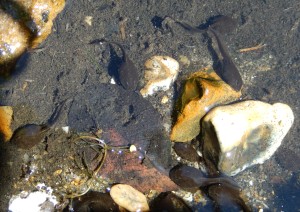
The Yellow Irises on the pond are starting to suffer from Iris Sawfly, a few of the leaves showing many small bite-marks along their margins.
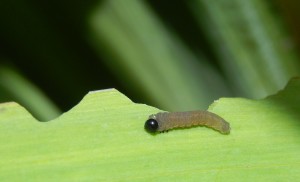
A small diving beetle obligingly came to the surface to replenish its air supply, staying up there for a minute and then zooming down to the bottom when I came close.
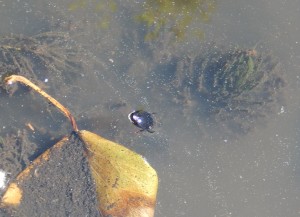
Insects in Gunnersbury Triangle
Ducklings at the Leg of Mutton Nature Reserve, Barnes (and House Martins)
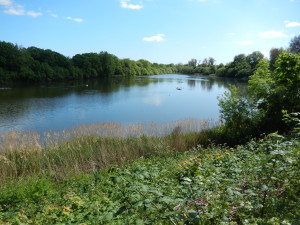
An unexpectedly warm and sunny afternoon in May is an opportunity too good to miss, so I went out with bicycle and binoculars along the river, and spent some time in the Leg of Mutton local nature reserve at Barnes. This is a bit of a secret corner, as it’s not far from the WWT’s London Wetland Centre which is certainly far better known. It’s also quite beautiful in springtime, the paths dressed in Queen Anne’s Lace (cow parsley to you) and the lake resplendently blue with new green borders. From the woods, Blackcaps sang all over; from the reeds, both Reed Warbler and Sedge Warbler sang their cheerful repetitive songs: I had a fine view of a Reed Warbler atop the reeds shown in the photo. A Coot with five cootlings scooted about the end of the lake (to the left); a mother Mallard escorted a neat convoy of ducklings; a few Tufted duck preened; five male Pochard dabbled heads-down; more surprisingly, a pair of Gadwall paddled about on the far side. A Mute Swan sat on a nest amongst the reeds. The flowers were visited by masses of small bees. Apart from the planes overhead, the city felt far away.
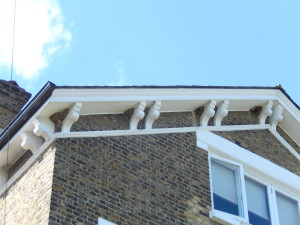
On the other side of the river (with the help of the handsome green Barnes Bridge) I had a wonderful surprise: House Martins. Four were wheeling and chattering above Chiswick Mall, right by a house decorated with a dozen House Martin nests (many of them visible in the photo), and several in usable condition. This was news to me because the old colony a few hundred yards away was abandoned for whatever reason some years ago. But it is clear that the birds have nested repeatedly in the past few years, and it certainly looks as if they’ll nest again this year. The only small fly in the ointment can be seen on the extreme left of the photo: there is the remains of at least one nest behind some netting, so the birds must have been considered a nuisance on that side of the house, at least. Let us hope that their presence on the front doesn’t trouble anyone, as the colony may well be the only one in Chiswick, and is certainly one of not very many in West London. Being by the river, there are plenty of flies, and the house’s wide eaves with stout supports are ideal for the species.
Moths and Warblers at Gunnersbury Triangle
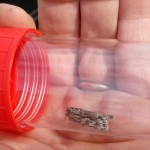
The dawn chorus at the reserve revealed two singing Blackcaps: one was alternately feeding on newly-emerged Cherry buds, presumably eating insect larvae, and giving short bursts of song or subsong. In a few days’ time the leaves will make such easy observation much less likely. There were two singing Chiffchaffs, one of them in full view in a Birch just coming into leaf above the main pond; and a Willow Warbler which I first heard yesterday near the picnic meadow.
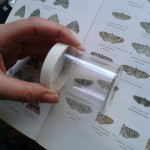
A party of newly-fledged Great Tits blundered about the bushes on the steps by the main pond, and a Wren gave me a fine view at the ‘mangrove swamp’, which is fast drying up. The newly-dug extension to the seasonal pond has filled with water and is in fact deeper than the rest of the pond, probably a useful variation in depth.
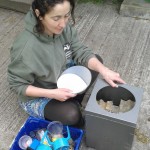
Up at the hut, the moth trap was being opened after a night’s work. Inside were some Pug moths, probably Brindled Pugs, and a much larger Noctuid moth, an Early Grey.
Also seen were Jay, Magpie, Carrion Crow, Wood Pigeon, singing Dunnock, Blackbird, Robin, Mallard. A Wren was carrying food to its nest near the ramp.
Digging a ditch
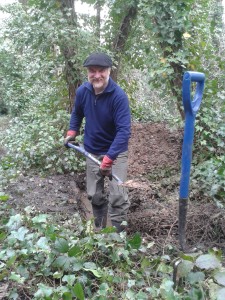
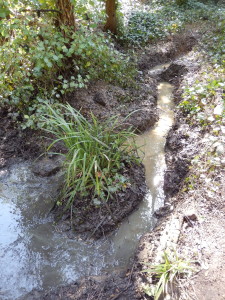
After just three short sessions of ditch-making, we have a little network of waterways, an island sporting a natural tuft of Pendulous Sedge, some impressively high banks of muddy, gravelly spoil, and a new feature for the reserve. We hope to extend the ditch down the natural line (was it a ditch before?) to the trees at the end. The existing seasonal pond certainly had a ditch-like extension to just across the path (from where the lower photo was taken), and we intend also to clear that out – it shouldn’t be difficult as, unlike the current ditchworks, there are no stones, roots or ivy entanglements to cut through.
Today (7 April) the sun shone in a cloudless spring sky, and we worked to the song of a Chiffchaff. Two Blackcaps were singing elsewhere in the reserve, along with Wrens, Dunnocks, Great Tits, Blue Tits and some non-vocal Magpies, a Jay, Wood Pigeons, a Heron and Mallard. The insects, too, have emerged to exploit the sudden warmth, with plenty of Peacock butterflies, a Brimstone or two, and a Holly Blue; I saw a Small White in my garden. There was a 7-spot and a Harlequin ladybird, and the pond was alive with a new crop of Pond Skaters.
The grass is racing up; Broom is coming into its handsome yellow pea-flowers; several tufts of garden-escape Mahonia and Daffodils are richly yellow; red deadnettles tempt several species of bumblebee including buff/white-tailed and carders, and the honeybees are active.

